-
Thursday 4th November 2010
About six months ago, when I was chatting to Cheryl's mum Virginia, or “Ginnie” as she's affectionately known, she mentioned that she would like to come and have a holiday with us. Jokingly, I offered that she could come and join us for the Atlantic crossing, tongue in cheek. A few months later, she came back to us and said she'd been thinking some more about coming to visit and would like to come and do the Atlantic crossing if the offer was still there.
Well, the Atlantic crossing is nearly upon us and Ginnie is on her way to Tenerife. Originally when she booked her flights here, we thought we'd be able to meet her with “Connect4” in Tenerife. Sadly, we're still in Lanzarote so Cheryl booked a short flight from Lanzarote to Tenerife to meet her mum off the plane.
Cheryl planned the flight so that she'd land just before her mum arrived, then they'd stay overnight in Santa Cruz and come back on a ferry Friday night arriving back in Lanzarote Saturday at 7:00am. That was the plan anyway.
With Cheryl gone, the rest of our family made the most of our time and splashed out for a $3.95 meat ball dinner at IKEA which is a 5minute walk from our little bay. John and Hannah from Naia felt like a night out, so joined us as well and we had a great evening of fine dining.
Back onboard “Connect4”, with tummy's full, we were just getting ready for bed when my mobile phone rang. Cheryl was at the Tenerife airport, in tears. It turns out that there are two airports in Tenerife – one in the north and the other in the south. Cheryl's flight landed at Tenerife North, while Ginnie's flight was landing in Tenerife South! Unfortunately they are about 60kms apart from each other and there was no way Cheryl could get from the north to the south in time to see her mother land.
Since Cheryl didn't have a mobile phone, I played go between and fortunately was able to convey to Ginnie all that had happened and got her into a taxi to meet Cheryl at her hotel. After a long taxi ride, Cheryl and Ginnie finally caught up with each other and . .. well I could finish tidying “Connect4” so that everything would be as pristine for Ginnie's arrival as I could make it, then I crawled into bed exhausted.
Saturday 6th November 2010

YAY!!! “Connect4” is now officially “Connect4 + 1” for the next few months. Ginnie arrived off the ferry this morning and after introducing her to “Willie”, our tender, we brought her and her bags back to “Connect4” to show her our fantastic floating home. Ginnie's initiation went well, and she successfully made it from the ferry dock (which at low tide was about a 6 metre climb down to the dingy!) to “Connect4” without getting wet or falling in.
Once onboard, and after the obligatory tour, “Connect4” looked and felt like Christmas as Ginnie slowly unpacked and handed out all the treasures, presents, letters and cards that she'd brought for us from Australia. Just for the record, we got six packets of Tim-Tams, two large cans of Milo, some Eucalyptus oil and a tub of Vegemite! How Australian is that? In addition Cheryl is thrilled to have some new underwear, a kitchen fire blanket, a whistling kettle, a toasting rack, two packs of Melba's “Inch Squares Liquorice” & a bag of Fruchocs! Me, well I got some red LED's for the nav station, some resistors, a couple of diodes and a “V” rescue signal sheet.

Tuesday 9th November 2010
After giving Ginnie a couple of days to get used to living onboard “Connect4” we pulled anchor and sailed from Puerto Naos down to Puerto Calera, a short 12NM hop where we stopped in the marina for a night before continuing onto Playa Blanca, our final destination. The trip to Playa Blanca was another hop of 10NM and we had smooth conditions for a motor sail.
Marina Rubicon is in Playa Blanca and we've arranged to get hauled out here in preparation for the Atlantic crossing. We badly need a fresh coat of anti-fouling, I need to install a ground plate for the SSB radio and I need to change the depth and speed sensors for the new ones that came with the instruments I bought back in Turkey. In addition, the problem with water getting in the sail drive oil was still a big issue to be resolved.
Tuesday morning dawned bright and early and we pulled anchor and made our way into the travel lift slip. We have a beam of 6.90m and the travel lift bay is narrow for us at 7.40m. If you do the calculations, and try to imagine it, that gives us barely 25cm on either side of “Connect4” - not much room for manoeuvring! Fortunately we had good friends in the anchorage, and with enough people on board, we managed to get “Connect4” man handled into the lift without incident.
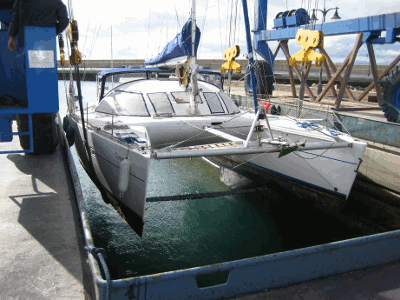
Then came the terrifying part! If you've ever owned a boat and watched it get lifted out of the water, then you'll understand exactly what I'm talking about. Do you know that feeling you get when you see your car get lifted up on the mechanic's car hoist? That worry about it falling off or getting damaged? Well imagine that it's happening to your house and everything you own! Watching your boat get lifted out of the water and carried across the marina, suspended by two straps, brings a knot to your throat and does nothing to lower blood pressure. I can't describe the hesitation I felt as I watched the travel lift start to lift my “Connect4” out of the water. To hear the groaning as the straps tightened around her belly as I felt her weight shift onto the lifting straps; it felt unnatural, somehow wrong.
I watched as the travel lift slowly moved her out of the water and over the hard. Only once she stopped moving and hung there suspended above the concrete hard did I remember to start breathing again. The workers set to power washing her barnacles and growth off, as we worked our way around behind the power wash, scraping the “glue” of the barnacles off and scrubbing the anti-fouling to get as much off as we could. After an hour or so, the bottom was mostly clean and she was moved over to the standing area and settled down on wooden blocks. This would be home for the next few days.

I've never anti-fouled a boat before, so this was a new experience for us. Over the next couple of days we sanded and cleaned and prepared “Connect4” for her new bottom paint. I pulled the sail drives to pieces and fitted new seals. Not being one to pick on poor mechanical workmanship, but I'm not the least bit surprised that the sail drive seals leaked. When I pulled the drives to pieces, there were two seals at the rear of the shaft. One of these seals is to keep the water out and the other is to keep the oil in. Surprisingly both these seals were facing the same direction – meaning I had two seals keeping the oil in, but nothing keeping the water out! The spacer that should have been between the two seals on the starboard drive was missing altogether, however when I pulled the port drive to pieces I found two spacers where there should have been one!
The ground plane for the SSB was fitted, as was the new sender units for the depth and the log. It's always a scary time when you have to drill new holes in the bottom of your boat, especially the ones below the waterline! I had to make sure that they were all sealed and secured properly. The thought of springing a leak mid way across the Atlantic could be a recipe for disaster!
We painted the new anti-fouling on the bottom and then after two nights and three days on the hard, we were relieved to be put back into the water. As soon as “Connect4” was floating, I jumped onboard and quickly ran around checking the holes for the ground plate and the new sensors. I was very relieved to see that there wasn't a drop of water coming in.

Having never done any of this work before, I have to confess I was at a loss as to the finer details of what to do. Fortunately, friends in the anchorage came forward and helped with all the jobs, and I was never short of instruction – for which I was eternally grateful. Geoff from “Duetto” came over a number of times and helped with the scrubbing and preparation and Gerry from “West by North” was amazing and helped continuously for the whole three days. The way that cruisers help each other is inspiring, but sometimes there are people that just go way beyond anything you could imagine. Gerry and Val from “West by North” are one such couple. I can't put into words the way that Gerry helped me with all the jobs on “Connect4” while we were on the hard. Every day he turned up, always smiling, always keen to offer advice or get stuck into some job. He'd work along side me until it got dark, then he'd be back the next morning ready to go again. For three days Gerry worked with me, and I can't express my gratitude to him for all he did. Even when we got put back into the water, Val invited all five of us over for dinner, so that we wouldn't have to cook. Gerry and Val are an inspiration to cruisers and have become such special friends to us.
Sunday 14th November 2010
After all work and no play, we hired a car and drove around the island of Lanzarote. We took Gerry and Val with us and the seven of us enjoyed a day out, exploring the arid volcanic landscape. First we drove to an ocean lookout where we saw where the lava flows had solidified when they met the water, distorted into craggy ravines and alien landscape formations. The last volcanic activity on the island was in the late 19th century, so the lava formations are still very coarse and the landscape undiminished by erosion.
While we were looking at the formations, Nick ran around collecting volcanic rock specimens. With a hand full of rocks he came running down the side of a hill, jumping the last metre onto the lava flow path. As he jumped onto the path, he stumbled and tripped and in slow motion we watched as his hand full of precious rocks flew out of his hand and in a smooth arc went skyward, over the edge of the lookout and down into the grotto below – lost forever. When we got to Nick, he was in tears, partly because of yet another bleeding knee and partly because of his lost rocks. Such is the life of a lad.
Next stop was the Parque Nacional de Timanfaya; a national park surrounding a volcano with some awesomely impressive lava fields. These lava fields are ragged and un-eroded and look not too dissimilar to how they would have looked shortly after the eruptions. The landscape looks like an alien field on some distant planet where nothing grows and the rocks rise up out of the solid ground in gravity defying shapes.

At the main park centre we got to see some natural hot tubes that were ejecting hot air from way below the ground at temperatures of around 250oC. When the guide put a dry bush in front of the air hole the bush burst into flames.
The restaurant made the most of the natural heating and cooked all their food over a giant circular grill that went down some fifteen to twenty metres below the surface of the ground, picking up the heat from the volcanic activity and using it to cook the food gently.

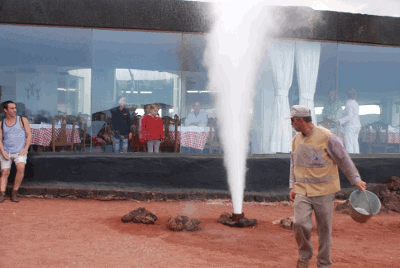
Outside the restaurant there were a number of hot air tubes that ran deep inside the earth. Within 6 metres of the surface, the the temperature rises quickly to around 400°C! One of the park rangers poured a bucket of water into one of the holes and within seconds the hole erupted in a violent geyser of steam, shaking the ground and making people duck for cover. After this demonstration, the ranger then warned us “When you use the toilet, you have 2 seconds to get off the seat quickly – you have seen what happens here!”.
We went on a bus tour around the park and got to see some incredible “unearthly” sights. The landscape was so surreal that it was hard to believe we were still on Earth. The destruction and the violence that must have surrounded this volcano is incomprehensible. The forces that would have to be wrought to cover a park 50 square kilometres with lava 5-20m deep is unimaginable. Reports from villagers and people living in the are when the volcano erupted, indicated that it continued to erupt for 6 years. When one fissure closed over, there would be a period of peace for a little while, but then another fissure would explode in another part of the park.
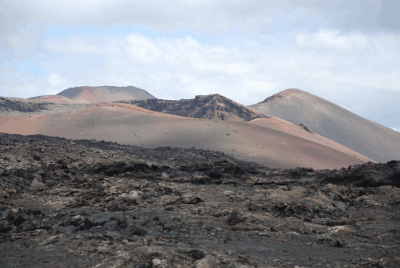
History tells us of the dramatic volcanic eruptions during the years 1730 to 1736, from which the Fire Mountains resulted. On the 1st of September in the year 1730, the most fertile lowlands of the island were struck by a tremendous natural catastrophe. More than thirty volcanoes belched forth fire and smoke and huge masses of magma burying in its wake. Fortunately the villagers had deserted earlier, so no casualties were recorded. These eruptions transformed almost a quarter of the island into a sea of solidified lava, multicoloured volcanic rocks and copper-coloured sand, with wide areas covered with thick layers of lapilli (coarse ash). These materials formed the malpaís (badlands), and more than 250 years after these eruptions, there is still hardly any vegetation on these lands. The volcano is dormant for now, though underneath the surface it's still bubbling and an odour of sulphur hangs in the air.

The second highlight of our tour around the island was undoubtedly a visit to the Cueva de Verdes underground Lava tube. Lava tubes are formed when a major lava flow makes its way down to the ocean, in this case from the volcano Monte Corona which erupted between 3000 and 5000 years ago. As the river of lava flowed towards the sea, the outer parts of the flow cooled, first forming a skin, then cooling to form a hard shell, while the hot lava continued to flow through the centre, like water does through a pipe.

Eventually the lava flow ceased and all that was left of the lava flow is the outer shell or lava tube. This particular lava tube extends nearly 7km's and is large enough in places to accommodate 500 people for a concert.
During the 18th century, the locals used to hide in the lava tubes to escape from the pirates that used to ravage the islands.
We went on a guided tour through the Cueva de Verdes and walked approximately 1km underground. Some parts of the tube system were so narrow that you had to duck to not bang your head, others were so wide that they opened up into huge chambers.
At one place, we walked up onto a terrace and got to see a spectacle in symmetry that was incomprehensible. If I hadn't seen it with my own eyes, I'd never have believed something so beautiful could have existed.

Monday 15th November 2010
We departed Marina Rubicon in Playa Blanca, Lanzarote enroute to Gran Tarajal, Fuerteventura. While it was only a sail of approximately 40NM, it was a good run for our newest crew member, since we had 25knots of wind from the North East. We had an excellent sail from the moment we departed until we dropped the sails in Fuerteventura. The new bottom paint made an amazing difference to our performance. We were running with one reef in the main, and admittedly sailing at 120o to the wind is a pretty good angle for us, but we still averaged 7.8knots over the duration of the sail and topped out at 10.3knots on one particular surf. The seas were off our aft quarter which made it a little rolly, but it was worth it. I even had to retune my auto pilot as with all the extra speed, it was not responding fast enough. Our newest crew member fared well, although there was one point in time when I thought I was about to lose her down the starboard steps. I was sitting at the helm, and Ginnie stuck her head out the saloon to talk to me. We'd told her “One hand for yourself and one hand for the boat when we're underway” and she was diligently remembering this rule. Unfortunately, she decided to use the boat hand to hold onto the sliding door of the companion way. A wave rolled us up and around and the door quietly slid shut as Ginnie staggered backwards towards the starboard saloon stairs. I was about to leap out of the helm and try to rescue her, fearing the worst that she may have fallen down the stairs, when the boat came off the wave and she performed a little drunken stagger back across the saloon, this time towards the port stairwell. Fortunately she stopped near the Nav station and regained her composure before finding a more secure hand hold for the next wave set.
Wednesday 17th November 2010
It was Cheryl's birthday today and she shared it with Geoff, a Kiwi, off “Duetto”. With so many boats in the little marina we decided to hold a pot luck dinner and invited anyone who wanted to come, to share in the birthdays. Chelsea, with some help from Grandma and Val off “West by North”, baked a beautiful birthday cake for Cheryl and Geoff. (It was a rugged mountain with two volcanoes!). The plan was to host the pot luck on either the narrow pontoon beside “Connect4” or on the roadside at the top of the pontoon.

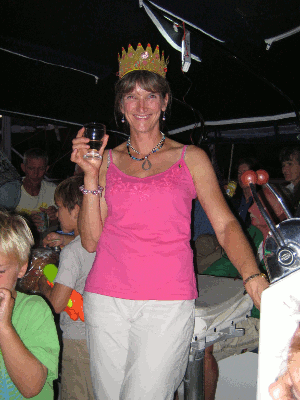
Well, the first load of friends came over and boarded, then the next lot came and put their food on the table. Before long it was clear that “Connect4” was definitely going to be the party boat, and we weren't moving to the dock! All up we had 34 people crowded into our little cockpit, with a few spilling over into the saloon. 34 is definitely a record for us and when I went to the dock I noticed our bottom transom steps were about 5cm under the water. I guess we were loaded up!
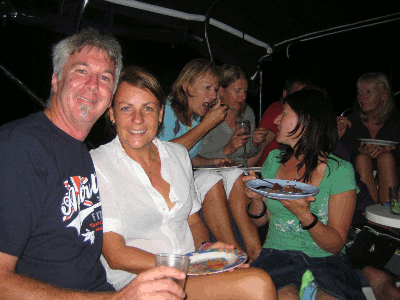
The night was great and we loved having all our friends over to help us celebrate. We missed not being with our family and friends from Adelaide, but Cheryl was made to feel very loved by all who attended.
We love cruising and wouldn't trade this life for anything, but we're aware, especially at times like this that the biggest cost to being so transient is that friends and family are a long way away.